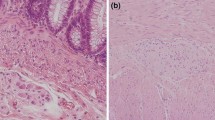Abstract
A prospective study of 141 consecutive patients with intestinal neuronal malformations is presented. The single malformation of the autonomic nervous system that always required surgical intervention was aganglionosis. Giant ganglia, reduced parasympathetic tone, immature ganglia, and hypogenetic or heterotopic nerve cells were seen in all forms of malformations. However, the incidence in specific malformations was variable. Multiple giant ganglia were identified in all patients with intestinal neuronal dysplasia (IND) type B, but also in various other malformations. Heterotopic nerve cells in the myenteric plexus were seen in the proximal segment of 15 of 74 patients (20.3%) with aganglionosis and 5 of 9 patients (55.6%) with hypoganglionosis. A significant impact on symptoms was found for IND type B: 34 (45.9%) of 74 children with aganglionosis had associated IND type B, and these children more frequently developed ileus (P < 0.001) and more often needed a second resection (P < 0.05) compared to those with isolated aganglionosis. This indicates an additive effect of both malformations, and therefore, in these patients an extended resection should be carried out.
Twelve of 67 patients (17.9%) without aganglionosis needed resection for untreatable constipation. This included 7 of 9 children with hypoganglionosis, both patients with heterotopia of the myenteric plexus, 1 of 20 with isolated IND type B, and 2 of 12 with reduced parasympathetic tone. None of the patients with immaturity, heterotopia of the submucous plexus, or mild dysganglionosis required surgery. Six children (8.9%) without aganglionosis underwent sphincteromyotomy and 2 with IND type B had a temporary colostomy. At follow-up (mean 2.4 ± 1.4 years), the outcome in patients with resected aganglionosis was better than in patients who had resections for other malformations; 49 (69%) of 71 patients with aganglionosis were asymptomatic compared to 4 (33.3%) of 12 with other malformations (P < 0.05). It is concluded that some intestinal malformations have a relevant clinical impact. However, the severity of symptoms in the individual patient may not be explained by specific histochemical findings from a limited number of mucosal biopsies. The pathognomonic histochemical criteria of isolated IND typeB — immaturity, reduced parasympathetic tone, heterotopia of the submucous plexus, and mild dysganglionosis —rarely require surgical therapy and should be treated conservatively.
Similar content being viewed by others
References
Meier-Auge W (1971) Über ein Erkrankungsbild des Colon mit Hirschsprung-Symptomatik. Verh Dtsch Ges Pathol 55: 506–510
Borchard F, Meier-Auge W, Wiebecke B, Briner J, Müntefering H, Födisch HJ, Holschneider AM, Schmidt A, Enck P, Stolte M (1991) Innervationsstbrungen des Dickdarms — Klassifikation und Diagnostik. Pathologe 12: 171–174
Holschneider AM, Meier-Auge W, Ure BM (1994) Hirschsprung's disease and allied disorders — a review. Eur J Pediatr Surg 4: 260–266
Meier-Auge W (1992) Epidemiology of congenital innervation defects of the distal colon. Virchows Arch Pathol Anat 420: 171–177
Holschneider AM, Ure BM, Pfrommer W, Meier-Auge W (1996) Innervation patterns of the rectal pouch and fistula in anorectal malformations: a preliminary report. J Pediatr Surg 31: 357–362
Ure BM, Holschneider AM, Meier-Auge W (1994) Neuronal intestinal malformations: a retro- and prospective study on 203 patients. Eur J Pediatr Surg 4: 279–286
Noblett HR (1969) A rectal suction biopsy tube for use in the diagnosis of Hirschsprung's disease. J Pediatr Surg 4: 406–408
Meier-Auge W, Schärli AF, Stoss F (1995) How to improve histopathological results in the biopsy diagnosis of gut dysganglionosis. Pediatr Surg Int 10: 454–458
Meier-Auge WA, Brönnimann PB, Gambazzi F, Schmid PC, Stoss F (1995) Histopathological criteria for intestinal neuronal dysplasia of the submucous plexus (type B). Virchows Arch 426: 549–556
Schärli AF (1992) Neuronal intestinal dysplasia. Pediatr Surg Int 7: 2–7
Krammer HJ, Meier-Auge W, Sigge W, Eggers R, Kühnel W (1994) Histopathological features of neuronal intestinal dysplasia of the plexus submucosus in whole mounts revealed by immunohistochemistry for PGP 9.5. Eur J Pediatr Surg 4: 358–361
Heitz PV, Komminoth P (1990) Biopsy diagnosis of Hirschsprung's disease and related disorders. Curr Top Pathol 59: 257–275
Goto S, Ikeda K (1985) Histochemical acetylcholinesterase activity in the mucosa of the resected bowel in Hirschsprung's disease. An analysis of 30 cases. Z Kinderchir 40: 26–30
Kobayashi H, Hirakawa H, Puri P (1995) What are the diagnostic criteria for intestinal neuronal dysplasia? Pediatr Surg Int 10: 459–464
Briner J, Oswald HW, Hirsig J, Lehner M (1986) Neuronal intestinal dysplasia — clinical and histochemical findings and its association with Hirschsprung's disease. Z Kinderchir 41: 282–286
Fadda B, Maier WA, Meier-Ruge W, Schärli A, Daum R (1983) Neuronale intestinale Dysplasie. Eine kritische 10-Jahres-Analyse klinischer und bioptischer Diagnostik. Z Kinderchir 38: 305–311
Fadda B, Pistor G, Meier-Ruge W, Hofmann-von Kap-herr S, Müntefering H, Espinoza R (1987) Symptoms, diagnosis, and therapy of neuronal intestinal dysplasia masked by Hirschsprung's disease. Pediatr Surg Int 2: 76–80
Hanimann B, Inderbitzin D, Briner J, Sacher P (1992) Clinical relevance of Hirschsprung-associated neuronal intestinal dysplasia (HANID). Eur J Pediatr Surg 2: 147–149
Koletzko S, Ballauff A, Hadzislelimovic F, Enck P (1993) Is histological diagnosis of neuronal intestinal dysplasia related to clinical and manometric findings in constipated children?. Results of a pilot study. J Pediatr Gastroenterol Nutr 17: 59–65
Munakata K, Morita K, Okabe I, Sueoka H (1985) Clinical and histologic studies of neuronal intestinal dysplasia. J Pediatr Surg 20: 231–235
Munakata K, Okabe I, Morita K (1992) Hypoganglionosis. Pediatr Surg Int 7: 8–11
Kaiser T, Steinau G, Skopnik H, Meier-Ruge W, Schumpèlik V (1995) Neuronale intestinale Dysplasie Typ B mit Befall von Magen, Dünn- und Dickdarm. Monatsschr Kinderheilk 143: 43–45
Simpser E, Kahn E, Kenigsberg K, Duffy L, Markowitz J, Daum F (1991) Neuronal intestinal dysplasia: quantitative diagnostic criteria and clinical management. J Pediatr Gastroenterol Nutr 12: 61–64
Author information
Authors and Affiliations
Rights and permissions
About this article
Cite this article
Ure, B.M., Holschneider, A.M., Schulten, D. et al. Clinical impact of intestinal neuronal malformations: a prospective study in 141 patients. Pediatr Surg Int 12, 377–382 (1997). https://doi.org/10.1007/BF01076944
Accepted:
Issue Date:
DOI: https://doi.org/10.1007/BF01076944




